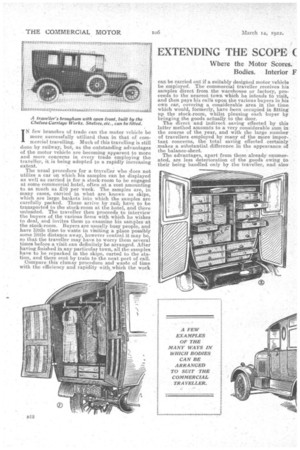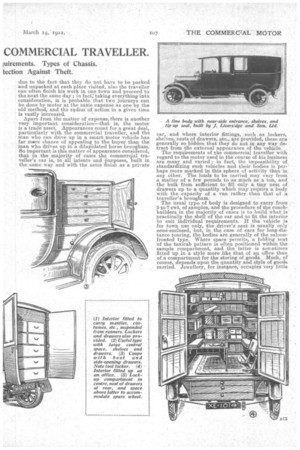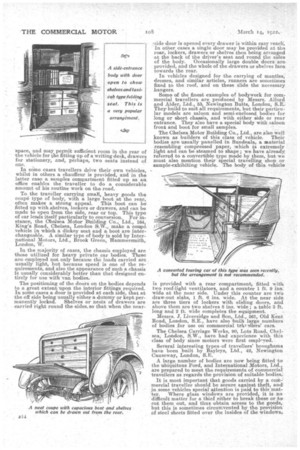EXTENDING THE SCOPE ( COMMERCIAL TRAVELLER.
Page 16

Page 17

Page 18

If you've noticed an error in this article please click here to report it so we can fix it.
Where the Motor Scores.
Bodies. Interior .F [uirements. Types of Chassis. tection Against Theft.
IN few branches of trade can the motor vehicle be more successfully utilized than in that of commercial travelling. Much of this travelling is still done by railway, but, as the outstanding advantages of the motor vehicle are becoming apparent to more and more concerns in every trade employing the traveller, it is being adopted to a rapidly increasing
extent. .
The usual procedure for a traveller who does not utilize a car on which his samples can be displayed as well as carried is for a stock-room to be engaged at some commercial hotel, often at a cost amounting to as much as £10 per week. The samples are. in many cases, carried in what. are known as skips, which are large baskets into which the samples are carefully packed. These arrive by rail; have to be transported to the stock-room at the hotel, and there unloaded. The traveller then proceeds to interview the buyers of the various firms with which he wishes to deal, and invites them to examine his samples at the stock-room. Buyers are usually busy people, and have little time to waste in visiting a place possibly some little distance away, however central it may be, so that the traveller may have to worry them several times before a visit can definitely be arranged. After having finished in any particular town, all the samples have to be repacked in the skips, carted to the station, and there sent by train to the next port of call.
Compare this clumsy procedure and waste of time with the efficiency and rapidity with,which the work can be carried out if a suitably designed motor vehicle be employed. The commercial traveller receives his samples direct from the warehouse or factory, proceeds to the nearest town which he intends to visit, and then pays his calls upon the various buyers in his own car, covering a considerable area in the time which would, formerly, have been occupied in fitting up the stock-room, whilst pleasing each buyer by bringing the goods actually to the door.
The direct and indirect saving effected by this latter method amounts to a very considerable sum in the course of the year, and with the large number of travellers employed many of the more important concerns' the total saving effected certainly makes a snhstantial differenee in the appearance of the balance-sheet.
The advantages, apart from those already enumerated, are less deterioration of the goods owing to. their being handled only by the traveller, and also due to the face that they do not have to be packed and unpacked at each place visited, also the traveller can often finish his work in one town and proceed to the next the same day ; in fact; taking everything into consideration, it is probable that two journeys can be done by motor at the same expense as one by the • old method, and the radius of action in a given time • is vastly increased.
Apart from the matter of expense', there is another very important consideration—that is, the motor is a trade asset. Appearances count for a great deal, particularly with the commercial traveller, and the man who can drive up in a smart motor vehicle has far more chance of appealing to the buyer than the man -who drives up in a dilapidated horse brougham. So important is this matter of appearance considered, that in the majority of cases the commercial traveller's car is, to all intents alid purposes, built in the same way and with the same finish as a private car, and where interior Atting8, such as lockers, shelves, nests of drawers' etc., are provided, these are generally so hidden that they do not in any way detract from the external appearance -of the vehicle.
The requirements of the c-ommercial traveller with regard to the motor used in the course of his business are many and varied ; in fact, the impossibility of standardizing such vehicles and their bodies is perhaps more marked in this sphere of actiVity than in any other. The loads to -be carried. may vary from a Matter of a few pounds to as much as a ton, and the bulk from sufficient to fill only a tiny nest of drawers up to a quantity which may require a body with the capacity of a van rather than that of a traveller's brougham.
The usual type of body is designed to carry from 5 to 7 cwt. of samples, and the procedure of the coachbuilders in the majority of -cases is to build what is practically the shell of the car and to fit the interior to suit individual requirements. If the vehicle is for town use only, the driver's seat is usually only semi-enclosed, but, in the case of cars for long-distance touring, the bodies are generally of the saloon-fronted type. Where space permits, a folding .seat of the taxicab pattern is often positioned within the sample compartment, and the latter is sometimes fitted up in a style more like that of an office than of.a compartment for the storing of goods. Much, of course, depends upon the quantity and style of goods carried. Jewellery, for instance, occupies very little space and may permit sufficient room in the rear of the vehicle for the fitting up of a writing desk, drawers for stationery, and, perhaps, two seats instead of one.
In some cases travellers drive their own vehicles, whilst in others a chauffeur is provided, and in the latter case a samples compartment fitted up as an office enables the traveller to do a considerable amount of his routine work on the road.
To the traveller carrying small, heavy goods the coupe type of body, -with a large boot at the rear, often makes a strong appeal. This boot can he fitted up with shelves, lockers or drawers, and can be made to open from the side, rear or top. This type of car lends itself particularly to conversion. For instance, the Ohelsea Motor Iltilding Co., Ltd., 164, King's Road, Chelsea, London S.W., make a coupe vehicle in which a dickey seat and a boot are interchangeable. A similar type of body is sold by International Motors, Ltd., Brook Green, Hammersmith, London, W.
In the majority of eases, the chassis employed are those utilized for heavy private car bodies. These are employed not only because the loads carried arc usually light, but because speed is one of the re9uirem-ents, and also the appearance of such a chassis its usually considerably better than that designed entirely for use with•van bodies.
The positioning of the doors on the bodies depends to a great extent upon the interior fittings required. In some cases a door is provided at each side, that at the off side being usually either A dulanny or kept permanently locked. Shelves or nests of drawers are carried right round the sides, so that when the near
[side door is opened every drawer is within easy reach. In other cases a single door may be provided at the rear, lockers, drawers or shelves then being arranged at die back of the driver's seat and round the sides of the body. Oceasionall7 large double doors are provided, and the whole of tie drawers or shelves face towards the rear.
In vehicles designed for the carrying of mantles, dresses, and similar articles, runners are sometimes fixed to the roof, and on these slide the necessary hangers.
Some of the finest examples of bodywork for commercial travellers are produced by Messrs. Alford and Alder, Ltd., 63, Newington Butts London, S.E. They huil•d-to suit all requirements, but their particular models are saloon and semi-enclosed bodies for long or short chassis, and with either side or rear entrance. They also have a special body with saloon front and boot for small samples.
The Chelsea MotelBuilding Co., Ltd., are also -well known as builders of this class of vehicle. Their bodies are usually panelled in Sundeala, a material resembling compressed paper'. which is extremely light and can be steamed to shape; we have already, referred to a convertible type made by them, but we must also mention their special travelling. shop or sample-exhibiting vehicle. The body of this vehicle
is provided with a rear compartment, fitted with two roof-light ventilators, and a counter I ft. 9 ins.' wide at the near side. Under this counter are two draw-out slabs, I ft. 6 ins. wide. At the near side, are three tiers of lockers with sliding doors, and above them are two shelves 8 ins. wide ; a table 3 ft.
long and 2 ft. wide completes the equipment. • Messrs. J. Liversidge and Son, Ltd., 561, Old Kent Road, London, S.E., have also built large numbers of bodies for use on commercial trre,Ilers' cars.
The Chelsea Carriage Works, 90, Lots Road, Chelsea, London, S.W., have had experience with this class of body since motors were first empleved.
Several interesting types-of travellers' broughams have been built by Bayleys, Ltd., 42, Newington Causeway, London, S.F., A large number of bodies are now being fitted to the ubiquitous Ford, and International Motors, Ltd., are prepared to meet the requirements of commercial' travellers as regards the provision of suitable bodies,'
It is most important that goods carried by a eoin-: inerciaI traveller should be secure against theft, and in some vehicles special attention is paid to this matter. Where glass windows are provided, it is no difficult matter for a thief either to break these or to cut them out, and thus obtain access to the goods, but this is sometimes circumvented by the provision of steel sheets fitted over the insides of the windows,'




























